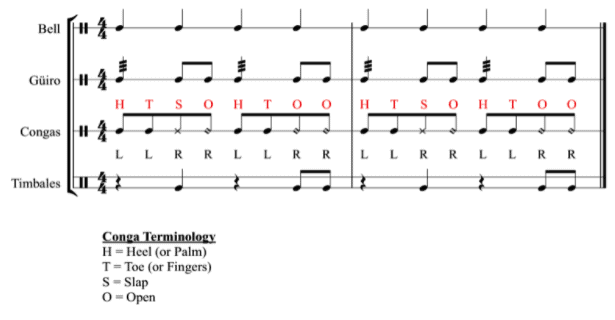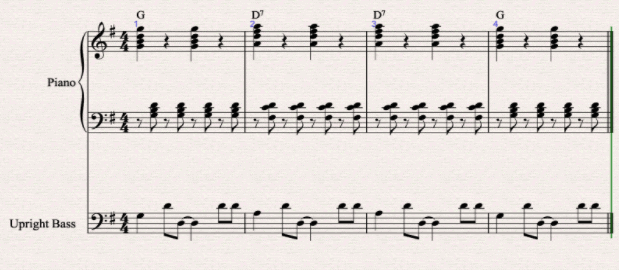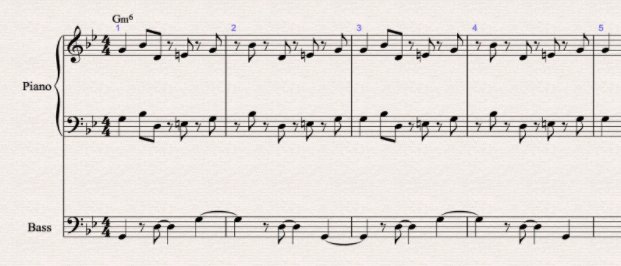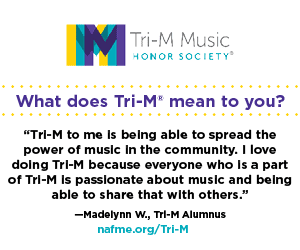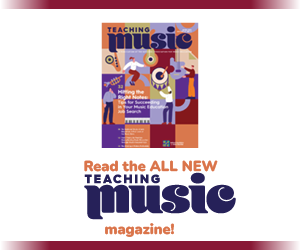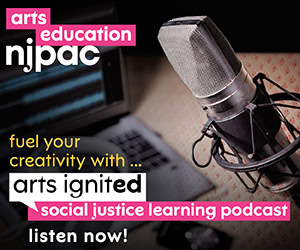/ News Posts / Cuban Music: Connections with the United States
Cuban Music
Connections with the United States
By NAfME Member Jeff Torchon
Jeff Torchon presented on “Cuban Music and Connections with the United States” during the NAfME 2021 PreK–12 Learning Collaborative in February 2021.
In 2006, I first watched the documentary “Buena Vista Social Club.” This film chronicles how musicians/producers Juan de Marcos González and Ry Cooder brought together older and forgotten Cuban musicians to revitalize traditional music on the world stage during the mid-1990s. I found the mixture of West African, European, Spanish, and Indigenous cultures to be magical. I traveled to Cuba to study music and returned with the desire to start a Cuban band and research musical styles from the island and how to incorporate them into the United States classroom. Through this work, I learned that Cuba and the United States have a rich musical connection that is often overlooked and worth exploring. I hope that this blog post introduces you to the island of Cuba, some of its musical traditions, and sparks ideas about how to incorporate this music into your classroom.

Brief History of Cuba
Cuba is the largest Caribbean island with a population of 11 million and is closer than Puerto Rico to the United States. In 1492, Columbus claimed the island for Spain. Shortly after, African enslaved people and Spanish settlers arrived and expanded the colony for the next few hundred years. In 1898, the Spanish-American War transferred control of Cuba to the United States allowing the United States to assert its influence until 1934 (Sublette, 2004). Music flourished in Cuba during the 1930s, 1940s, and 1950s, and cultural sharing between the island and the United States was strong. With the onset of communism and the Cuban Revolution in 1959, this musical connection between countries was severed, but has slowly re-emerged in recent years.
Traditional Cuban Music
Cuban music is a collection of many cultures—Spanish, European, African, and the Indigenous people of Cuba such as the Arawak, Taíno, and Ciboney (Sublette, 2004). These peoples and their influences helped to create various styles such as Son, Bolero, Cha-Cha-Chá, and Danzón.
| Spanish | European | African | Indigenous People |
| ● Guitar
● Flamenco ● Language |
● Song form
● Instruments (piano, brass, woodwinds) ● Western European classical styles |
● Drums
● Bell ● Call and response ● Various rhythms |
● Maracas
● Güiro |
Danzón and the Cha-Cha-Chá
Danzón music originated in 1879 and became popular in Cuban dance halls. The style combines classical rondo form, an orchestra-like instrumentation known as Orquesta Típica, and the cinquillo rhythm to add an African element (Roy, 2002).
Alterations to the instrumentation and experimentation during the 1940s helped transform the Danzón into the Cha-Cha-Chá during the 1950s through the work of violinist and composer Enrique Jorrín.
Musical attributes of Cha-Cha-Chá include:
- Simple melodies with an easy-to-remember chorus (Garcia, 2013)
- Simple and repetitive harmonic progressions
- Repeated rhythm section parts
 Son
Son
This style developed in eastern Cuba during the late 1800s and arrived in Havana in the early part of the twentieth century as a sextet (voice, tres, bass, maracas, clave, bongo) (Roy, 2002). Son groups traveled to New York City in the 1920s to perform and record (Roy, 2002). In the 1940s and 1950s, the smaller Son groups grew into Banda Gigantes (Big Bands) and Conjuntos, which helped influence Salsa and Latin Jazz.
Musical attributes include:
- Simple harmonic progressions
- Call and response
- Repeated rhythm section parts (bongo, congas, clave, maracas)
- Cyclical montuno pattern in the piano and/or guitar
- Tumbao pattern in the bass accenting beat 4
- Son Clave rhythm (Mauleón-Santana, 1999)
Clave
An essential rhythm and instrument (claves) in Cuban Son music. In English, clave means “key.” It is literally the rhythmic key that holds this style of music together. There are many variations of the clave pattern, but the Son Clave is one of the most well-known.
This rhythm has roots in West Africa, came to Cuba by way of the slave trade, and became part of the Son style (Sublette, 2004). The 3-2 Son Clave traveled to New Orleans via cultural sharing during the 1800s, became part of the foundation of Jazz, and permeated through other musical traditions in the United States such as Rock ‘n Roll, Blues, Country, Pop, and Rock.
Some examples of the 3-2 Clave Pattern in United States musical styles include:
- “Bo Diddley”—Bo Diddley
- “I Want Candy”—Bow Wow Wow
- “Faith”—George Michael
- “In the Waiting Line”—Zero 7
Suggested Activities for the Classroom
- Students can view “Roots of Rhythm,” a documentary that outlines the blending of various cultures and musical traditions in Cuba (see worksheet below).
- Students can view “Buena Vista Social Club,” the documentary described earlier in this blog post (see worksheet below).
- Students can learn the percussion rhythms of the styles and perform them.
- Students can listen to songs in the styles and analyze what they hear.
- Students can learn the Son clave rhythm and search for it in popular songs in the United States.
- Teachers can program songs in these styles for Band/Chorus/Orchestra or other ensembles at their school.
Online resources:
Documentaries:
Rosow, E., Dratch, H., Post, L., Belafonte, H., Estefan, G., Puente, T., Gillespie, D., … Public Broadcasting Service (U.S.). (2001). Roots of rhythm. United States: Docurama.
Wenders, W., Madman Entertainment (Firm), & Kanopy (Firm). (2018). Buena Vista Social Club.
Worksheets:
References
Garcia, D. (2013). Cha cha chá. In The Grove Dictionary of American Music (2nd ed.) Retrieved From http://www.oxfordmusiconline.com.libproxy.temple.edu/subscriber/article/grove/music/A2248833
Manuel, P., & Bilby, K. (1995). Caribbean currents: Caribbean music from rumba to reggae. Philadelphia: Temple University Press.
Mauleón-Santana, R. (1999). 101 Montunos. Sher Music Co.
Roy, M. (2002). Cuban music: From son and rumba to The Buena Vista Social Club and timba cubana. Princeton, NJ: Markus Wiener.
Sublette, N. (2004). Cuba and its music from the first drums to the mambo. Chicago, IL: Chicago Review Press.
Also see “Cuban Cha-Cha-Chá: Applications for Music Education in the United States” by Jeff Torchon in the June 2018 issue of Music Educators Journal.
About the author:
 NAfME member Jeff Torchon is a musician and a music educator in the Philadelphia area and is currently a PhD student and graduate assistant in music education at Temple University. Prior to starting this program, Jeff taught middle and high school music at Germantown Friends School for eight years. He is a graduate of the Boyer College of Music and Dance at Temple University and has both his Bachelor’s Degree and Master’s Degree in Music Education with a concentration in Jazz Piano. Since 2010, Jeff has led a Cuban music ensemble in Philadelphia called Conjunto Philadelphia. Their main mission is to perform music of Pre-Revolutionary Cuba, including the Son, Cha-Cha-Chá, and Bolero and pay homage to Cuba’s deep and treasured musical history as well as infuse a new energy and fresh interpretation into the music. He resides in Ardmore, Pennsylvania, with his wife and two sons.
NAfME member Jeff Torchon is a musician and a music educator in the Philadelphia area and is currently a PhD student and graduate assistant in music education at Temple University. Prior to starting this program, Jeff taught middle and high school music at Germantown Friends School for eight years. He is a graduate of the Boyer College of Music and Dance at Temple University and has both his Bachelor’s Degree and Master’s Degree in Music Education with a concentration in Jazz Piano. Since 2010, Jeff has led a Cuban music ensemble in Philadelphia called Conjunto Philadelphia. Their main mission is to perform music of Pre-Revolutionary Cuba, including the Son, Cha-Cha-Chá, and Bolero and pay homage to Cuba’s deep and treasured musical history as well as infuse a new energy and fresh interpretation into the music. He resides in Ardmore, Pennsylvania, with his wife and two sons.
Personal Website: www.conjuntophilly.com
Personal LinkedIn: https://www.linkedin.com/in/jefftorchon/
Did this blog spur new ideas for your music program? Share them on Amplify! Interested in reprinting this article? Please review the reprint guidelines.
The National Association for Music Education (NAfME) provides a number of forums for the sharing of information and opinion, including blogs and postings on our website, articles and columns in our magazines and journals, and postings to our Amplify member portal. Unless specifically noted, the views expressed in these media do not necessarily represent the policy or views of the Association, its officers, or its employees.
Published Date
July 27, 2021
Category
- Culturally Relevant Teaching
- Culture
- Diversity, Equity, Inclusion, and Access (DEIA)
- Repertoire
- Representation
Copyright
July 27, 2021. © National Association for Music Education (NAfME.org)


